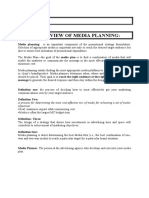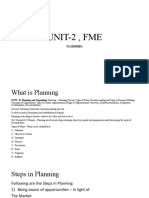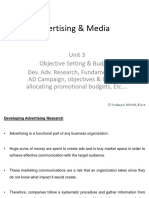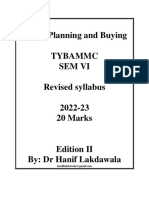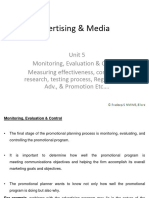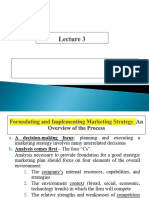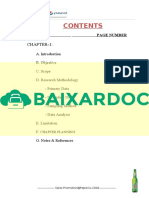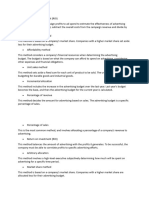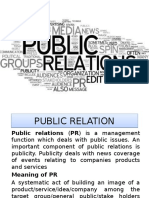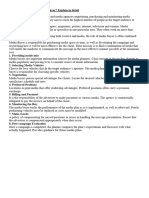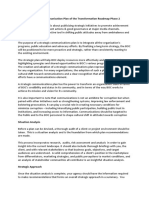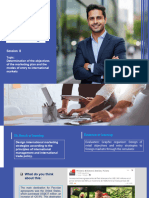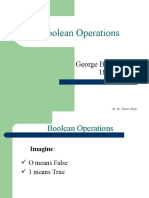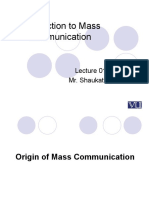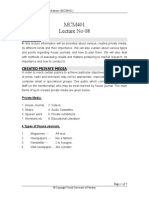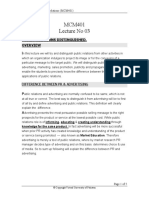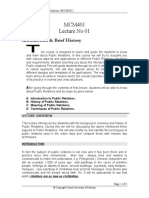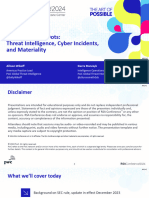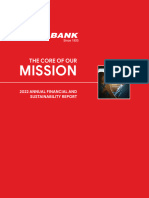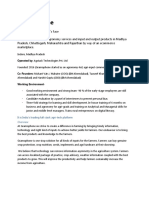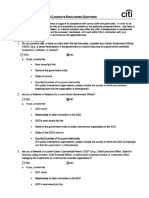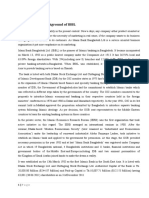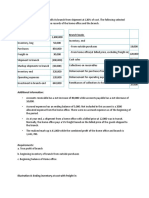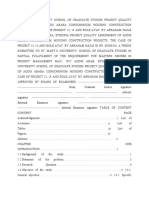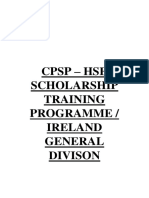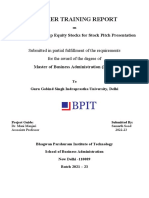Planning Public Relations Programmes
Planning Public Relations Programmes
Uploaded by
bc200200813 JUNAID ARSHADCopyright:
Available Formats
Planning Public Relations Programmes
Planning Public Relations Programmes
Uploaded by
bc200200813 JUNAID ARSHADOriginal Title
Copyright
Available Formats
Share this document
Did you find this document useful?
Is this content inappropriate?
Copyright:
Available Formats
Planning Public Relations Programmes
Planning Public Relations Programmes
Uploaded by
bc200200813 JUNAID ARSHADCopyright:
Available Formats
Fundamentals of Public Relations –MCM 401 VU
PLANNING PUBLIC RELATIONS PROGRAMMES
Overview
This lecture will explain about the methods and essentials of planning public relations
program. It is important to consider and determine as to how these can be planned for
tangible results. Although once again we will be talking on broad scale yet this can be
adapted to suit particular or more modest requirements.
4 Reasons for Planning PR Programs.
1. Set targets for PR Operation -- (Against which results can be assessed.)
2. Estimate the working hours and other costs involved for such PR Plan.
3. Select priorities which will control the number and timing of different operations in the
program.
4. Decide feasibility of carrying out declared objectives according to availability of:
• Sufficient staff of proper caliber.
• Specific equipment like computers, cameras, vehicles etc.
• Adequate Budget.
6 Point PR Planning Model
In order to plan a successful and result oriented PR plan following model should be
adopted;
• Appreciation of the situation.
• Definition of objectives.
• Definition of publics.
• Selection of media & techniques.
• Planning of a budget.
• Assessment of results.
Let us now study the above enumerated parameters of successful PR plan model
individually.
Appreciation Of The Situation
Methods Of Appreciating A Situation
In order to prepare an effective strategy to counter a situation it is important that the
gravity of situation should first be assessed and appreciated. Following are the
universally tried and accepted methods of appreciating a situation.
• Opinion, attitude or image surveys.
• Press clippings, monitored broadcasting scripts.
• Sales figures trends & sales report indications,
• State of competition within & from imports.
HOSTILITY
PREJUDICE
APATHY
IGNORANCE
SYMPATHY
ACCEPTANCE
INTEREST
© Copyright Virtual University of Pakistan
Fundamentals of Public Relations –MCM 401 VU
KNOWLEDGE
NEGATIVE SITUATION POSITIVE SITUATION
• Share price if Public Company, dividends, balance sheet etc.
• Industrial relation situation.
• Customer complaints, test reports & product performance.
• Discussion with sales force & distributors.
• Prices & effect of price changes.
• Market forces, economic, social & political.
Definition Of Objectives.
1. Change the image because company has changed its activities.
2. Improve the caliber of job applicants.
3. Tell people about little known story of the company & gain credit for achievement.
4. Make company known & understood in new local & international markets.
5. Prepare stock market for a new share launch.
6. Improve community relations following public criticism based on misunderstanding of
company’s intention.
7. Educate installers, users or consumers about the product.
8. Regain public confidence after a disaster which had portrayed company as inefficient
in any way, the cause having been rectified.
9. Establish a new corporate identity.
10. Support a sponsorship scheme.
11. Make politicians better informed about company’s activities, perhaps because of
some impending legislation which could affect the company unfavorably.
12. Propagate company’s research activities.
When we determine the objectives it is essential that we should first of all identify the
public we want to target from various publics, as already enumerated in the previous
lectures also. Broadly speaking there are two major publics classified as internal and
external while following are the expanded publics in the modern day.
Expanded Publics.
• The Community.
• Potential Employees.
• Employees.
• Suppliers of services & materials.
• Investors --- the money market.
• Distributors.
• Consumers & users.
• Opinion leaders.
Selection of Media & Techniques.
Once the objectives have been worked out and the publics selected, it will be necessary to
select the media and technique to be adopted for the achievement of the desired
objectives. It is important as in relation to the objectives, determined publics identified,
only the selection of proper public will yield positive results.
Following is the classification of different media as in use in the present days.
© Copyright Virtual University of Pakistan
Fundamentals of Public Relations –MCM 401 VU
Print Media Electronic Media
1. Press. 1. Radio
2. Printed Material. 2. Television.
3. Direct Mail.
4. House Journals
Misc. Media
1. Exhibitions.
2. Air balloons & ships.
3. Electronic Bill Boards.
While determining the media and required techniques it is essential and important that
before launching a public relations plan a budget should also be worked out. In this
context following is the five point strategy.
5 Points For Planning PR Budget
1. To determine, what will it cost to carry out a PR Plan.
2. What sort of plan can be carried out for a given sum of money?
3. After agreeing to a cost & Plan, budget provides a check list to tasks, to be done as per
a time table.
4. Budget sets a discipline for both expenditure & over - expenditure.
5. After completion of campaign, results can be measured against the budget.
Assessment Of Results
Once all essentials like objectives, proper identification of publics and selection of media
and techniques are in place and the cost involved for such plan has been worked out on
the above explained strategy, it is imperative that an assessment should be made with
regard to the public relations plan about the results or achievement of the objectives on
following lines even if these may be qualitative and not quantitative.
• Evaluate results.
• Adopt proper evaluating methods.
• Compare results against Objectives.
Sometimes the results may not be measurable statistically, but by experience and self
evident qualities such as the evidence that now job applicants are better educated and
more proficient or in some other way more suitable than before. These are basically the
qualitative results. However, the quantitative results may show increased sales, awareness
and reduced number of complaints, increased job applicants, oversubscription of shares
or even increased number of mentions of the company name in the media.
© Copyright Virtual University of Pakistan
You might also like
- Assignment 2-Business EnvironmentDocument60 pagesAssignment 2-Business Environmenthoanggiang4445No ratings yet
- Project Report On Marketing Mix On PepsiDocument53 pagesProject Report On Marketing Mix On PepsiSudeep Chhotaray82% (61)
- Economic Problems of Pakistan and SolutionsDocument8 pagesEconomic Problems of Pakistan and SolutionsYousuf Zahid73% (15)
- 12 Point Campaign PlanDocument2 pages12 Point Campaign PlanErmin ĆelahmetovicNo ratings yet
- Proposals & Competitive Tendering Part 1: Strategy & Positioning to Win (Second Edition)From EverandProposals & Competitive Tendering Part 1: Strategy & Positioning to Win (Second Edition)No ratings yet
- Sathya Dinesh CH 17BBAD070 Consumer Insights and Behaviour: The Schiffman & Kanuk's Model of Consumer Decision MakingDocument6 pagesSathya Dinesh CH 17BBAD070 Consumer Insights and Behaviour: The Schiffman & Kanuk's Model of Consumer Decision MakingSathya DineshNo ratings yet
- Chapter 8 - The Marketing PlanDocument41 pagesChapter 8 - The Marketing PlanMelissa Linda BandiezNo ratings yet
- BUSG2001 Unit 6 The Market PlanDocument24 pagesBUSG2001 Unit 6 The Market PlanGharamNo ratings yet
- Marketing PlanDocument21 pagesMarketing Plansourabh sagdeoNo ratings yet
- Unit 4: Building Marketing and PR PlanDocument30 pagesUnit 4: Building Marketing and PR PlanSony TvNo ratings yet
- ADV - Module 4 - UpdatedDocument29 pagesADV - Module 4 - UpdatedAnil vermaNo ratings yet
- Media PlanningDocument42 pagesMedia PlanningtraincrashgurujiNo ratings yet
- Media Strategy and PlanningDocument16 pagesMedia Strategy and PlanningGHULAM FATIMANo ratings yet
- Session 7Document33 pagesSession 7Brijlal MallikNo ratings yet
- (Exam THCM) 08.5.2024Document11 pages(Exam THCM) 08.5.2024Phạm Nguyên QuânNo ratings yet
- MPB NotesDocument34 pagesMPB NotesMitanshi MandowaraNo ratings yet
- FME Unit 2 PlanningDocument12 pagesFME Unit 2 PlanningNagilla AnjaliNo ratings yet
- Unit 3 - Obj - BudgetDocument24 pagesUnit 3 - Obj - Budgetkashishparikh68No ratings yet
- Develop an Advertising Plan (1) Unit 3Document25 pagesDevelop an Advertising Plan (1) Unit 3ashishdamseth10No ratings yet
- Media Planning and Buying 20 MARKS 2022 - 23 - Notes For Students With SolutionDocument27 pagesMedia Planning and Buying 20 MARKS 2022 - 23 - Notes For Students With SolutionRiya MishraNo ratings yet
- Chapter 8 The Marketing PlanDocument22 pagesChapter 8 The Marketing Planmkahnum12No ratings yet
- Module IIIDocument47 pagesModule IIISambhav BhansaliNo ratings yet
- Managing Mass CommDocument25 pagesManaging Mass Commvimalrparmar001No ratings yet
- Pembahasan Isi MakalahDocument10 pagesPembahasan Isi MakalahNovianita FirdaNo ratings yet
- Advertising Campaign PlanningDocument20 pagesAdvertising Campaign Planningsarah x70% (10)
- Principles and Practice of Services Marketing AS2Document12 pagesPrinciples and Practice of Services Marketing AS2Thandapani PalaniNo ratings yet
- Unit 5 - Monitoring - ControlDocument66 pagesUnit 5 - Monitoring - Controlkashishparikh68No ratings yet
- Ilovepdf MergedDocument27 pagesIlovepdf Mergedmariam hosamNo ratings yet
- Project Report On Marketing Mix On PepsiDocument10 pagesProject Report On Marketing Mix On PepsiDevanti RawatNo ratings yet
- PR Planning and Executing The Public Relations' CampaignDocument20 pagesPR Planning and Executing The Public Relations' CampaignIuliaNo ratings yet
- Strategic Marketing Planning: Chapter 2 - Ferrell and Hartline 6 EditionDocument16 pagesStrategic Marketing Planning: Chapter 2 - Ferrell and Hartline 6 EditionAyesha LatifNo ratings yet
- EMM Assessment Brief 2023 DebraDocument4 pagesEMM Assessment Brief 2023 Debrakucukoglusema45No ratings yet
- Return On InvestmentDocument7 pagesReturn On InvestmentHemo ThiyamNo ratings yet
- Five Stages of an Effective Digital Marketing PlanDocument5 pagesFive Stages of an Effective Digital Marketing PlanMurtaza MuhammedNo ratings yet
- Dba 501 Advanced Statistics For Business Decision and ResearchDocument3 pagesDba 501 Advanced Statistics For Business Decision and ResearchNajeb TomagaNo ratings yet
- Demand ForecastingDocument48 pagesDemand ForecastingMegha SharmaNo ratings yet
- Advertisement BudgetDocument5 pagesAdvertisement Budgetsenguptasrijita230No ratings yet
- The MKTG PlanDocument41 pagesThe MKTG PlanJames NitsugaNo ratings yet
- PRDocument30 pagesPRAdarsh KrishnaNo ratings yet
- Media Planning and BuyingDocument12 pagesMedia Planning and BuyingBAMMC-526Dwiti MandaviyaNo ratings yet
- Media Planning - 2Document120 pagesMedia Planning - 2samNo ratings yet
- Module 9: The Business Plan: Learning ObjectivesDocument5 pagesModule 9: The Business Plan: Learning ObjectivesMichael Jorge BernalesNo ratings yet
- Media Planning Revised NotesDocument70 pagesMedia Planning Revised Notesbs3535696No ratings yet
- The Marketing Plan: Entrepreneurship Development Chapter - 8 (Hisrich, 6e)Document21 pagesThe Marketing Plan: Entrepreneurship Development Chapter - 8 (Hisrich, 6e)dhruv patelNo ratings yet
- Chapter 7: Marketing and Advertising Planning Top-Down, Bottom-Up and IMCDocument5 pagesChapter 7: Marketing and Advertising Planning Top-Down, Bottom-Up and IMCPrateek ChaudharyNo ratings yet
- PSM Chapter-2Document21 pagesPSM Chapter-2Shahed AhamedNo ratings yet
- Workshop and Preparation of Marketing PlanDocument25 pagesWorkshop and Preparation of Marketing PlangiselleNo ratings yet
- Advertising Planning, Budgeting, 4p'sDocument6 pagesAdvertising Planning, Budgeting, 4p'sSiddharth SharmaNo ratings yet
- Parts of Business PlanDocument35 pagesParts of Business PlanLuna Mia100% (1)
- SOSTAC & TOPPSEED Marketing Communications PlanDocument73 pagesSOSTAC & TOPPSEED Marketing Communications PlanGaurav Pratap Singh100% (1)
- B2B Marketing CommunicationsDocument12 pagesB2B Marketing CommunicationsSiddhartha GhoshNo ratings yet
- Communication StrategyDocument7 pagesCommunication StrategytalhachaudhryNo ratings yet
- BOC Develop A Strategic Communication Plan of The Transformation Roadmap Phase 2Document25 pagesBOC Develop A Strategic Communication Plan of The Transformation Roadmap Phase 2Mario FranciscoNo ratings yet
- Principles in MarketingDocument17 pagesPrinciples in MarketingSimbarashe hungweNo ratings yet
- Chapter 2 Lesson 2Document12 pagesChapter 2 Lesson 2Dark PrincessNo ratings yet
- An Overview of Media PlanningDocument105 pagesAn Overview of Media PlanningTejalNo ratings yet
- SESION No8Document27 pagesSESION No8lechavezcau01No ratings yet
- Sales Management: Chapter - 02Document23 pagesSales Management: Chapter - 02Shariful IslamNo ratings yet
- Unit 10 Media Selection, Planning and Scheduling: ObjectivesDocument29 pagesUnit 10 Media Selection, Planning and Scheduling: ObjectivesRajesh DasNo ratings yet
- Each Element of An IMC Strategy Must Have A Well-Defined Purpose and Support N Extend The Message Delivered by All The Other ElementsDocument49 pagesEach Element of An IMC Strategy Must Have A Well-Defined Purpose and Support N Extend The Message Delivered by All The Other ElementsprakashmbaaNo ratings yet
- Global Expansion Route-to-Market Options for Scale-Ups: Guidelines for addressing Route-to-Market choices during international expansionFrom EverandGlobal Expansion Route-to-Market Options for Scale-Ups: Guidelines for addressing Route-to-Market choices during international expansionNo ratings yet
- Mass Storage: Magnetic SystemDocument12 pagesMass Storage: Magnetic Systembc200200813 JUNAID ARSHADNo ratings yet
- Hexadecimal Notation: RepresentationDocument6 pagesHexadecimal Notation: Representationbc200200813 JUNAID ARSHADNo ratings yet
- Main Memory: Storing A BitDocument8 pagesMain Memory: Storing A Bitbc200200813 JUNAID ARSHADNo ratings yet
- 05 PpsDocument16 pages05 Ppsbc200200813 JUNAID ARSHADNo ratings yet
- 06 PpsDocument9 pages06 Ppsbc200200813 JUNAID ARSHADNo ratings yet
- 09 PpsDocument5 pages09 Ppsbc200200813 JUNAID ARSHADNo ratings yet
- MCM401 Lecture No. 11: This Lecture Will Cover The Problems Which A PR Practitioner Has To Face in TheDocument4 pagesMCM401 Lecture No. 11: This Lecture Will Cover The Problems Which A PR Practitioner Has To Face in Thebc200200813 JUNAID ARSHADNo ratings yet
- Introduction To Mass Communication - MCM 101 VUDocument2 pagesIntroduction To Mass Communication - MCM 101 VUbc200200813 JUNAID ARSHADNo ratings yet
- Introduction To Mass Communication: Lecture # 03 Mr. Shoukat AliDocument15 pagesIntroduction To Mass Communication: Lecture # 03 Mr. Shoukat Alibc200200813 JUNAID ARSHADNo ratings yet
- 08 PpsDocument7 pages08 Ppsbc200200813 JUNAID ARSHADNo ratings yet
- Boolean Operations: George Boole (1815-1864)Document7 pagesBoolean Operations: George Boole (1815-1864)bc200200813 JUNAID ARSHADNo ratings yet
- Introduction To Mass Communication: Mr. Shaukat AliDocument17 pagesIntroduction To Mass Communication: Mr. Shaukat Alibc200200813 JUNAID ARSHADNo ratings yet
- Introduction To Mass Communication - MCM 101 VU: Elements of Communication and Early Communication ModelsDocument6 pagesIntroduction To Mass Communication - MCM 101 VU: Elements of Communication and Early Communication Modelsbc200200813 JUNAID ARSHADNo ratings yet
- Introduction To Mass Communication - MCM 101 VU: Types and Forms of CommunicationDocument3 pagesIntroduction To Mass Communication - MCM 101 VU: Types and Forms of Communicationbc200200813 JUNAID ARSHADNo ratings yet
- Data Storage: Dr. M. Tanvir AfzalDocument8 pagesData Storage: Dr. M. Tanvir Afzalbc200200813 JUNAID ARSHADNo ratings yet
- Introduction To Mass Communication - MCM 101 VUDocument2 pagesIntroduction To Mass Communication - MCM 101 VUbc200200813 JUNAID ARSHADNo ratings yet
- Introduction To Mass Communication: Mr. Shaukat AliDocument8 pagesIntroduction To Mass Communication: Mr. Shaukat Alibc200200813 JUNAID ARSHADNo ratings yet
- Introduction To Mass Communication - MCM 101 VUDocument3 pagesIntroduction To Mass Communication - MCM 101 VUbc200200813 JUNAID ARSHADNo ratings yet
- Introduction To Mass Communication - MCM 101 VUDocument3 pagesIntroduction To Mass Communication - MCM 101 VUbc200200813 JUNAID ARSHADNo ratings yet
- Lesson 10Document3 pagesLesson 10bc200200813 JUNAID ARSHADNo ratings yet
- Introduction To Mass Communication - MCM 101 VU: Message - Root of Communication IDocument3 pagesIntroduction To Mass Communication - MCM 101 VU: Message - Root of Communication Ibc200200813 JUNAID ARSHADNo ratings yet
- Lesson 09Document4 pagesLesson 09bc200200813 JUNAID ARSHADNo ratings yet
- Lesson 13Document5 pagesLesson 13bc200200813 JUNAID ARSHADNo ratings yet
- MCM401 Lecture No. 12: - Basically The Purpose of Public Relations Is ToDocument3 pagesMCM401 Lecture No. 12: - Basically The Purpose of Public Relations Is Tobc200200813 JUNAID ARSHADNo ratings yet
- Lesson 08Document7 pagesLesson 08bc200200813 JUNAID ARSHADNo ratings yet
- Lesson 07Document5 pagesLesson 07bc200200813 JUNAID ARSHADNo ratings yet
- MCM401 Lecture No 03: Public Relations Distinguished. IDocument5 pagesMCM401 Lecture No 03: Public Relations Distinguished. Ibc200200813 JUNAID ARSHADNo ratings yet
- MCM401 Lecture No 01: Introduction & Brief HistoryDocument3 pagesMCM401 Lecture No 01: Introduction & Brief Historybc200200813 JUNAID ARSHADNo ratings yet
- Lesson 02Document4 pagesLesson 02bc200200813 JUNAID ARSHADNo ratings yet
- Allaine OJTDocument1 pageAllaine OJTwengcalva.railtechNo ratings yet
- 2024 USA24 ANI R03 01 Connecting The Dots Threat Intelligence CyberDocument42 pages2024 USA24 ANI R03 01 Connecting The Dots Threat Intelligence CyberGopinathNo ratings yet
- CBCAFSR22 20230413 Press Quality 1Document330 pagesCBCAFSR22 20230413 Press Quality 1Nevan NovaNo ratings yet
- Legal Notice AjinkyaDocument3 pagesLegal Notice AjinkyaAbhigyat ChaitanyaNo ratings yet
- SNC Lavalin Safety ManualDocument150 pagesSNC Lavalin Safety ManualmeddyfarrahNo ratings yet
- DTC Participant in Numerical Sequence 3Document24 pagesDTC Participant in Numerical Sequence 3Ann BoudreauxNo ratings yet
- Day TRADER and Swing TraderDocument1 pageDay TRADER and Swing TradersimonomuemuNo ratings yet
- Gramophone Company ProfileDocument5 pagesGramophone Company ProfileSHEKHAR SUMITNo ratings yet
- Income Data 2018 PhilippinesDocument3 pagesIncome Data 2018 PhilippinesCarlos EspedidoNo ratings yet
- Of Information: Anti-Bribery Corruption Candidate Disclosure QuestionsDocument2 pagesOf Information: Anti-Bribery Corruption Candidate Disclosure Questionsanh sy tranNo ratings yet
- 1.0 Historical Background of IBBLDocument25 pages1.0 Historical Background of IBBLShuvo GhoshNo ratings yet
- CH 8 Numerical ExampleDocument3 pagesCH 8 Numerical Examplediana.p7reiraNo ratings yet
- Create The Perfect Linkedin Profile: A 6-Step Guide For RecruitersDocument20 pagesCreate The Perfect Linkedin Profile: A 6-Step Guide For RecruitersContact BizstreetNo ratings yet
- Proposal For Panlelists and InvitationDocument10 pagesProposal For Panlelists and InvitationVanshika GuptaNo ratings yet
- Jurnal UAS TPKDocument13 pagesJurnal UAS TPKM.NawwaruddinNo ratings yet
- Home Office and Branch Accounting Example ProblemDocument3 pagesHome Office and Branch Accounting Example ProblemKathleene100% (2)
- Professional Web Video - Plan, Produce, Distribute, Promote and Monetize Quality VideoDocument308 pagesProfessional Web Video - Plan, Produce, Distribute, Promote and Monetize Quality VideoEliseuJoséDosSantos100% (1)
- Getachew ReferanceDocument70 pagesGetachew ReferanceTehut AleneNo ratings yet
- Essay 5 Practice Activities - DBS IntroductionsDocument6 pagesEssay 5 Practice Activities - DBS IntroductionsLeyla IsayevaNo ratings yet
- Advert For AED 2021 FinalDocument2 pagesAdvert For AED 2021 FinalSalehe abdallahNo ratings yet
- Ukur+Tanah+Land+Surveyor 8929071Document1 pageUkur+Tanah+Land+Surveyor 8929071geomateer5949No ratings yet
- Lecture - Salvatore Iare-Mefa-PptsDocument519 pagesLecture - Salvatore Iare-Mefa-PptsKahimbiNo ratings yet
- CPSP-HSE ScholarshipDocument16 pagesCPSP-HSE ScholarshipTabish Ramzan100% (1)
- 013-Samarth Sood - (STR)Document53 pages013-Samarth Sood - (STR)Sumit BaghelNo ratings yet
- The Waterfall Model in Large-Scale Development: Abstract. Waterfall Development Is Still A Widely Used Way of WorkingDocument2 pagesThe Waterfall Model in Large-Scale Development: Abstract. Waterfall Development Is Still A Widely Used Way of WorkingSaadi SiddiquiNo ratings yet
- Industrial ManagementDocument11 pagesIndustrial Managementanirban.manna.fit.cse21No ratings yet
- 03 Quiz 1 AubDocument3 pages03 Quiz 1 Aubken dahunanNo ratings yet















